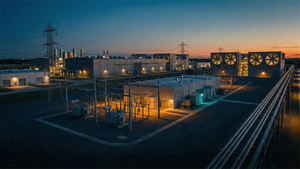
A palpable sense of caution is sweeping through the financial markets as leading research firm BCA Research issues a stark warning: the burgeoning enthusiasm for Artificial Intelligence (AI) capital expenditure (capex) might be hurtling towards a "Metaverse Moment." This ominous prediction suggests a critical inflection point where the market's current widespread optimism about AI investments could sour, akin to the investor disillusionment that followed the initial hype and massive spending in the metaverse. The immediate implication for investors is a call for heightened vigilance and a re-evaluation of exposure to AI-linked assets, as the sustainability and profitability of the current AI spending spree come under intense scrutiny.
BCA Research's "Metaverse Moment" is not merely a hypothetical scenario but a cautionary parallel drawn from recent history. It posits that a significant shift in market sentiment will occur when a major AI company announces increased capital expenditure, only for its stock price to subsequently decline. This would signal a fundamental change from unbridled enthusiasm to a more skeptical assessment of the return on these monumental AI investments. This warning is underpinned by several observations, including projections that hyperscale companies like Amazon (NASDAQ: AMZN), Google (NASDAQ: GOOGL), Meta (NASDAQ: META), Microsoft (NASDAQ: MSFT), and Oracle (NYSE: ORCL) could accumulate an astonishing $2 trillion to $2.5 trillion in AI-related assets by 2030. The annual depreciation costs alone for these assets could reach $400 billion to $500 billion by 2030, potentially overshadowing the combined current earnings of these tech behemoths. This raises serious questions about the long-term sustainability and profitability of such extensive capital outlays.
The Unfolding Narrative of AI Capex and BCA's Warning
The narrative leading up to this moment has been one of unprecedented growth in AI-related capital expenditure. Over the past few years, fueled by advancements in large language models (LLMs) and generative AI, tech giants have embarked on an aggressive spending spree to build out the necessary infrastructure—data centers, specialized chips, and cooling systems—to power the AI revolution. Companies like Nvidia (NASDAQ: NVDA), the dominant player in AI accelerators and GPUs, have seen their valuations soar, reflecting their critical role as the backbone of this infrastructure. However, BCA Research's chief global strategist, Peter Berezin, highlights that the justification for this immense spending is becoming increasingly tenuous. He suggests that LLMs might deliver fewer productivity gains than anticipated and that many investors may be overestimating both the transformative economic impact of AI and its potential for profit.
Furthermore, early warning signs are already emerging. Data indicates a potential plateau in AI adoption rates, and GPU rental rates, a key indicator of demand for AI infrastructure, have shown a downward trend. These signals suggest a possible slowdown in the actual deployment and utilization of AI technologies compared to the rapid pace of investment. Instances of negative market reactions, such as Meta Platforms (NASDAQ: META) and Oracle (NYSE: ORCL) experiencing stock dips after announcing increased capital expenditure, are cited as harbingers of this shifting sentiment. The free cash flow of hyperscalers has also reportedly fallen, a trend reminiscent of telecom stocks before the dot-com bubble burst. BCA Research's warning serves as a crucial reality check, urging investors to consider the possibility that the AI capital expenditure boom could peak within the next 6 to 12 months, with 2026 potentially marking a significant turning point in the overall AI investment cycle.
Winners and Losers in the AI Investment Landscape
The potential "Metaverse Moment" for AI capital expenditure presents a complex scenario for public companies, creating both potential winners and significant losers. Companies directly investing in AI, particularly the hyperscale cloud providers, stand to be most affected. Tech giants like Microsoft (NASDAQ: MSFT), Alphabet (NASDAQ: GOOGL), Amazon (NASDAQ: AMZN), and Meta Platforms (NASDAQ: META) are pouring billions into AI infrastructure and research. If the skepticism around AI capex intensifies, these companies could face increased investor scrutiny on the return on investment (ROI) of their massive outlays. Companies failing to demonstrate clear paths to monetizing their AI initiatives could see significant stock price declines, similar to Meta's previous struggles with its metaverse investments. Reduced profitability, declining free cash flow, and potential debt burdens from extensive infrastructure buildouts could force strategic re-evaluations, potentially slowing down expansion plans or consolidating efforts.
On the other hand, providers of AI infrastructure, such as chip manufacturers and data center operators, also face considerable risk. Nvidia (NASDAQ: NVDA), Advanced Micro Devices (NASDAQ: AMD), Broadcom (NASDAQ: AVGO), and Micron Technology (NASDAQ: MU) have seen their fortunes tied closely to the AI boom, supplying the essential hardware. A slowdown in AI investment would directly translate into reduced orders for chips, networking equipment (from companies like Arista Networks (NYSE: ANET) and Ciena (NYSE: CIEN)), and servers (from Super Micro Computer (NASDAQ: SMCI) and Dell (NYSE: DELL)). This could lead to decreased demand, revenue slowdowns, inventory build-ups, and pricing pressures, severely impacting their profit margins and valuations, which are often "priced for perfection." Data center providers like Equinix (NASDAQ: EQIX) and Digital Realty Trust (NYSE: DLR), currently expanding aggressively, could face challenges if overbuilding leads to excess capacity that cannot be monetized quickly enough. While the underlying technology remains transformative, a "Metaverse Moment" would force a re-evaluation of investment strategies across the board, potentially favoring companies with more diversified revenue streams and stronger balance sheets to weather a period of lower returns.
Wider Significance and Historical Echoes
The growing skepticism around AI capital expenditure and the "Metaverse Moment" warning transcend individual company performance; they signal a broader recalibration within the technology sector with significant wider implications. This shift aligns with a broader industry trend moving from pure hype to a demand for practicality and measurable returns from AI investments. Companies are increasingly scrutinizing their AI budgets, prioritizing clear ROI over ambitious, speculative projects. This could lead to a "flight to quality," where investors gravitate towards established tech giants that are seen as essential infrastructure providers in the AI landscape, while smaller, more speculative AI ventures struggle for funding. The transformation of historically "asset-light" tech giants into "asset-heavy" entities due to massive infrastructure investments is also a notable trend, raising questions about long-term returns on invested capital, as asset-heavy models are often associated with lower returns.
The potential ripple effects are substantial. A slowdown in investment could hinder the pace of AI development and innovation, particularly for startups. A sharp market correction, if it materializes, could trigger broader economic slowdowns, given AI's current contribution to GDP growth. Investor confidence would undoubtedly take a hit, potentially leading to a widespread "risk-off" sentiment. Regulatory bodies are also increasingly focused on AI's ethical implications, such as bias, data privacy, and intellectual property, leading to calls for greater transparency and risk mitigation. The European Union's AI Act, set to come into force around mid-2024, is a prime example of an evolving regulatory landscape that investors must navigate. Historically, the current situation draws strong parallels to the dot-com bubble of the late 1990s, where speculative investment outpaced actual technological capabilities, leading to extravagant valuations and ultimately a dramatic market correction. Other historical bubbles, such as the 19th-century railway mania, also serve as cautionary tales of overinvestment and excess competition. While some argue that today's tech giants have stronger fundamentals than their dot-com predecessors, the sheer scale of capital accumulation in risky assets, including AI, suggests a potential for systemic fragility.
Navigating the Road Ahead: What Comes Next
The path forward for AI capital expenditure and the market is poised at a critical juncture, presenting a spectrum of short-term and long-term possibilities. In the immediate future, robust AI capital expenditure from hyperscalers like Amazon (NASDAQ: AMZN), Google (NASDAQ: GOOGL), Microsoft (NASDAQ: MSFT), and Meta Platforms (NASDAQ: META) is expected to continue, driving a significant portion of current US GDP growth. However, this aggressive spending will be met with increasing investor demand for tangible results and a clear path to profitability. The short-term will likely see continued market volatility influenced by geopolitical risks and the ongoing performance of key AI players.
Long-term, AI is widely regarded as a profound, transformative infrastructure buildout, comparable to historical technological revolutions. Projections suggest global data center infrastructure capex could reach nearly $7 trillion by 2030, driven by the continuous need for computational power. However, the "Metaverse Moment" warning highlights the enduring risk of capital destruction if the anticipated returns do not materialize. Strategic pivots will be crucial; companies are expected to shift their focus from mere capital expenditure to demonstrating clear free cash flow generation and a tangible ROI from their AI investments. This means a greater emphasis on companies that effectively use AI to boost revenue and reduce costs in their core businesses, rather than solely those building the foundational infrastructure. Consolidation within the AI sector is also a likely outcome, with large tech giants potentially solidifying their dominance by outspending smaller competitors, and innovative startups becoming attractive acquisition targets. Investors should prepare for potential scenarios ranging from a significant market correction mirroring past tech busts to a more sustainable, ROI-driven growth phase that favors companies adept at integrating and monetizing AI effectively.
Comprehensive Wrap-Up and Investor Outlook
The growing skepticism surrounding AI capital expenditure and the "Metaverse Moment" warning from BCA Research represents a pivotal moment for the financial markets and the future of artificial intelligence. The key takeaway is a fundamental shift in market sentiment from unbridled enthusiasm to a more pragmatic and cautious assessment of AI investments. While AI's transformative potential remains undeniable, the sheer scale of current capital expenditure, coupled with concerns about diminishing returns and unsustainable spending, necessitates a rigorous re-evaluation by investors. The parallels to historical tech bubbles, particularly the dot-com era, serve as a potent reminder of the dangers of speculative excess.
Moving forward, the market will likely differentiate between companies that can effectively translate their AI investments into tangible revenue growth and improved profitability, and those that merely engage in an "AI arms race" without a clear monetization strategy. Investors should closely monitor the free cash flow generation of hyperscale companies, the actual adoption rates of AI technologies, and the evolution of GPU rental rates. The focus should shift towards companies demonstrating strong returns on invested capital from their AI initiatives and those leveraging AI to enhance their core business operations. While the long-term trajectory of AI is still expected to be upward, the coming months will be critical in determining whether the current investment frenzy leads to a sustainable revolution or a painful "Metaverse Moment" correction. Diligence, diversification, and a keen eye on financial fundamentals will be paramount for navigating this complex and potentially volatile landscape.
This content is intended for informational purposes only and is not financial advice




